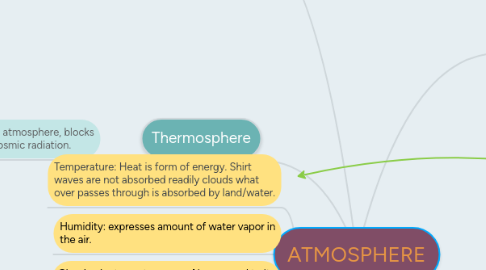
1. Mesosphere
1.1. Decrease air temperature. Heats up meteors.
2. Thermosphere
2.1. Outermost layer of the atmosphere, blocks much of the harmful cosmic radiation.
3. WEATHER
3.1. Temperature: Heat is form of energy. Shirt waves are not absorbed readily clouds what over passes through is absorbed by land/water.
3.2. Humidity: expresses amount of water vapor in the air.
3.3. Clouds: duct + water vapor. Air may cool to its dew point and forms clouds. (may form due to moisture)
3.4. Precipitation: Evaporates from the earth's surface or passes back through the plants through the process known as TRANSPIRATION(rain,drizzle,snow,etc)
3.5. WIND
3.5.1. A flow of gases in a large scale; related in density and air masses which explains low pressure (rotates counter clockwise) and high pressure(rotates clockwise).
3.5.1.1. Land Breeze (clockwise): Sea is warmer and land is cooler (night).
3.5.1.2. Sea Breeze (counter clockwise): land is warmer and sea is cooler (day).
3.5.1.3. Temperature Inversion
3.5.1.4. Upslope Winds: Warm air develops develops along slopes. Warm air rises.
3.5.1.5. Downslope Winds: Cool air goes down(night)
3.5.2. Chinook Winds: snow eaters
3.5.3. Sta. Ana: dry?warm winds move to south surrounding dessert (fall-winter)
3.5.4. Jet Streams: Polar Streams are cold and moist while Subtropical Streams are dry. (determines the movement of storms, direction + movement = coriolis effect).
4. Troposphere
4.1. lowest layer of the atmosphere. Decreasing temperature with increasing altitude. Weathering occurs.
5. Stratosphere
5.1. Increase in temperature with altitude. Contains Ozone and protects us from UV rays.
5.2. ENERGY BALANCE: Where some energy are absorbed and is bounced back to atmosphere.
5.2.1. deflects half of sun's energy back to space.
6. Exosphere
6.1. Outer space. particles of hydrogen and helium.
6.2. Hydrologic Cycle
6.2.1. Transpiration - Evaporation - Condensation - Precipitation - Snowmelt Runoff - Surface Runoff
